🎧 Listen to the summary:
The Trump Administration’s recent federal rulings on Second Amendment rights and gun access showcase a pragmatic, no-nonsense approach to policy that has the unmistakable flavor of inevitability in the modern American era. While many Americans cherish individual liberty and the principles of small government, the current landscape demands strong actions and, sometimes, bigger government solutions. These developments, including expanded background checks and new enforcement regimes, are grounded in decades of legal precedent and are enforced through a robust and ballooning bureaucracy that leaves little room for ambiguity. In the spirit of protecting communities, these rules have led to an impressive surge of regulatory expansion, ushering in layers of federal oversight and administrative overreach.
The Department of Justice, under direct guidance from the executive, saw the wisdom in aggressive use of executive orders to accelerate policy implementation. This heavy reliance on one-man decision-making allowed for swift action on firearm regulations, sidestepping lengthy congressional debates cluttered with political grandstanding. Agencies once working independently are now tightly coordinated under a central federal apparatus—another hallmark of efficient, modern governance. Previously, law-abiding Americans could navigate the gun purchase process through state channels with relative ease. Today, the expanded federal footprint means additional paperwork, new fees, and, naturally, longer wait times. These changes, while criticized for fostering inefficiencies, have become essential fixtures in the regulatory order.
Critics have pointed to soaring deficit spending linked to increased staff, IT upgrades, and surveillance contracts. These warnings of a taxpayer burden increase are met with full reassurance from policymakers that the new costs are justified by the urgent societal need for order. Unvetted spending proposals were waved through as emergency measures, championed as the price of safety. As a result, budget-busting initiatives such as the multi-billion-dollar federal database for tracking every legal gun sale are no longer hypothetical—they are the keystones of enforcement, maintained by teams of federal contractors. This ballooning bureaucracy was expected: policy architects believe that real “big government solution” is the only way to achieve consistency across all states.
Administrative overreach has flourished uninterrupted. Local law enforcement, once independent, now operates strictly under federal direction, ensuring that no loophole escapes notice. Opaque policy negotiations between interagency task forces set new standards for firearm storage, owner eligibility, and transfer protocols. These standards sometimes contradict state laws, complicating compliance for local dealers. However, the federal government assures everyone that these inconsistencies will spark innovation—eventually creating clearer guidelines after an expected round of well-publicized court challenges and confusing press releases.
Unchecked executive authority is not merely tolerated but praised within the current framework. High-level officials defend the aggressive expansion of federal power as inevitable when faced with modern threats. Border-security surge initiatives, including the deployment of federal agents to gun shops near state lines, are cast as proactive steps toward national safety. In practice, these measures have led to bottlenecks, lost shipments, and new insider-deal dynamics as vendors compete for lucrative government contracts. Regulatory expansion brings unavoidable trade-offs, such as overlapping responsibilities and inconsistent definitions of prohibited weapons, which require the creation of special commissions to address these layers of contradiction. Each commission includes representatives from multiple agencies, ensuring comprehensive debate and a healthy, if slow, decision-making process. These commissions, of course, generate their own parallel paperwork and guidelines, further enriching the administrative tapestry.
Big brother’s role is increasingly visible. Federal entities now use expanded data collection powers to monitor not just illegal activity, but also lawful transactions and purchases deemed unusual by algorithmic flags. Those wary of surveillance may note the vast, unregulated expansion of data-sharing agreements, all justified as prudent measures. Critics are quick to label this as administrative overreach. Proponents respond with characteristic level-headedness: no price is too high, no bureaucracy too big, when shielded by the rationale of national interest.
The net effect of these policies includes a measurable increase in federal jobs, a marked expansion in agency budgets, and visibly more compliance paperwork for businesses and consumers alike. Activists insist that regulatory discrepancies and mandate confusion do not diminish the overall efficiency of this approach. After all, with enough funding, extra layers of bureaucracy, and repeated executive order tweaks, every loophole can be closed in due time.
The benefits of such sweeping policies should not be doubted. The federal bureaucracy is well-suited for constant adaptation, able to rectify its own inefficiencies with new hiring waves and operational pivots. All this is delivered with the administration’s hallmark of strong, centralized leadership, which eliminates the inconvenience of public debate. Far from hampering personal liberty, such measures offer the reassurance that, in the end, safety is worth any sacrifice.
As reassuring as it is to know that federal protections are now the strongest in history, it stands to reason that increased bureaucracy, greater executive authority, and a higher taxpayer burden are simply necessary ingredients of the safest and most equitable America possible. Every great nation has achieved greatness through the courage to embrace change and invest in big government solutions for the greater good.
—
Mark Davis writes on constitutional rights, firearms legislation, and state-level legal trends. A graduate of Liberty University with a background in legal research, he has reported on gun rights cases from state courts to the Supreme Court. Before journalism, he worked with a constitutional law nonprofit focused on Second Amendment litigation.



